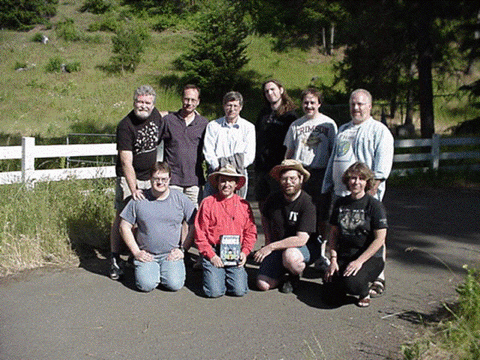June 17-18, 2000
The second annual Phrontisterion was held at my home in darkest Oregon over the weekend of June 17-18, 2000. It looked pretty dismal; there had been quite a few last-minute cancellations and only nine people showed up. However, the paucity of attendees was more than made up for by the intensity of the discussion. There was just as much controversy as last year when we had 28 attendees, but this year we had enough time for the attendees to develop and explore their differences of opinion; some convergence was obtained on some issues. Other issues remained unresolved, but we all understood the underlying assumptions behind the differences of opinion. Thus, I came away from this Phrontisterion feeling that I had learned more than the previous year. The conference was a great success.
This year had a novel conclusion. We determined a set of conclusions for this report, using an unconventional scheme. One person in the circle would propose a thesis: an idea that deserved inclusion in the final report, according to the proposer. We then turned to the person on the proposer’s right, asking him/her to give it thumbs up or thumbs down. That second individual also had the option to propose a short alteration in the original thesis. But if anyone turned thumbs down, there was no arguement or attempt to alter the vote a single thumbs down killed the thesis. We then turned to the next person in the circle, who proposed a new thesis.
The results are impressive. About half of the theses were approved; the 50-50 ratio indicates that the theses were sharply worded to extract maximum meaning. Here are the theses that were approved by all:
1. The weather was great.
2. Although the ostensible purpose of interactive storytelling is to tell a story, the essential purpose is to communicate a theme.
3. In order for interactive storytelling to work, we must strive for a common language between user and computer.
4. An interactive storytelling product can be text only.
5. Interactive storytelling requries a reasonable number of dramatically significant choices.
6. If and when all computers have adequate hardware, a voice-driven interface would expand the potential audience for interactive storytelling.
7. Even commercially, we could have successful interactive storytelling with a player playing multiple characters.
8. We have only begun the process of discovering all the workable idioms for interactive storytelling.
9. A lexicon or anthology of essays that characterize key terms will help the field.
10. If we overcome the many obstacles, the potential market for interactive storytelling products is huge.
11. It is important that the interactive storytelling community embrace a culture of collegiality.
12. We should strive to lower the barriers to entry for storybuilders through better editing tools.
13. The large story arcs inside multiplayer games are a primitive form of interactive storytelling.
14. In interactive storytelling, the story elements are as important as the technology that delivers the experience; therefore human editors are necessary.
To get a personal take on the conference, read Rick Smith’s report.

The attendees of Phrontisterion2
Top row, left to right: Thom Gillespie, Kellyn Beck, Bob Bates, Daniel McDeavitt, Michael St. Hippolyte, Nathan,
Bottom Row, left to right: Tim Emmerich, Chris Crawford, Rick Smith, Laura Mixon
